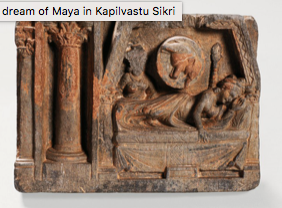
The next section focuses on the architecture of Gandharan monasteries and temples, in particular stupas from which many of the reliefs displayed originate. Throughout this area, the now familiar imagery of Buddhism can be explored in the stories of Buddha’s life, including his “birth, enlightenment, first sermon, and attainment of Nirvana.”1The effort this section makes to place the artistic work into a larger context is important as, obviously, these pieces have been parted from their stupas. However, in placing them in conjunction and making efforts to explore the functionality of stupas and the connection of Buddha’s imagery to those places of worship, the viewer is better able to visualize the artifacts as they were. This, in and of itself, is not truly unique, though, as most museums seek to provide context to their displays. What sets this section apart then, is not quite its use of context, but its variety of works and broad range of styles and presentations, intended to give the fullest idea of the arts’ multiplicity.
This careful selection of comparatives can be seen in the imagery of Dipankara and Maya’s Dream andThe Dream of Maya in Kapilvastu, which, despite depicting the same subject and being of the same era, diverge drastically in their presentation with The Dream of Maya in Kapilvastu appearing to be of a greater Greco-Roman influence as compared to Dipankara and Maya’s Dream.2On the other hand, however, the near identical poses of the woman highlights the intersectionality of the tale, showing that it successfully carried across cultural and artistic lines or else that one directly influenced the work of the other.


- “The Buddhist Heritage of Pakistan: Art of Gandhara.” Asia Society.
- Ed. Proser, Adriana. The Buddhist Heritage of Pakistan: Art of Gandhara.